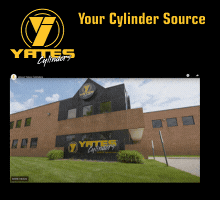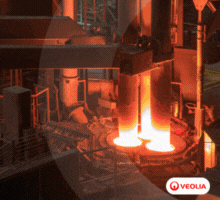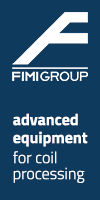Outokumpu Sees Stainless Steel Market Picking Up
05/02/2014 - As it reported its first quarter results, Outokumpu reiterated its cautiously optimistic view of the markets for the second quarter.
Highlights in the first quarter 2014
In line with management expectations Outokumpu’s operational performance continued to improve in the first quarter and underlying EBIT loss was € 45 million. Operating cash flow was € -14 million.
New definition of underlying profitability
Following the change in Outokumpu’s metal hedging policy in the beginning of 2014, Outokumpu has changed the definition of its underlying profitability. The new definition of the underlying profitability follows the company’s underlying profit development by eliminating the impact of non-recurring items, raw material related inventory gains/losses and metal derivative gains/losses.
Raw material-related inventory gains/losses as well as metal derivative result is presented as net effect. The historical figures were not adjusted as the new hedging policy was implemented in the beginning of 2014 and is not applicable to past periods.
Business and financial outlook for the second quarter of 2014
Outokumpu extends its cautiously optimistic view of the markets for the second quarter. Underlying demand is estimated to continue recovery and the recent rally in the nickel price is expected to have a positive impact on market dynamics. The company estimates similar or somewhat higher delivery volumes and some improvement in base prices for the second quarter. The steady progress in the cost efficiency initiatives and synergies is expected to continue.
For the second quarter of 2014, Outokumpu estimates that the underlying EBIT will improve, but will be still at a loss. At current metal prices, net impact of raw material-related inventory and metal derivative gains/losses on profitability is expected to be marginal.
Going forward, Outokumpu’s operating result is likely to be impacted by non-recurring items associated with the Group’s ongoing restructuring programs, but significantly less than in the first quarter. This outlook reflects the current scope of continuing operations of Outokumpu.
CEO Mika Seitovirta commented: “The first quarter was important for us for many reasons: we completed the divestment of Terni and VDM, finalized comprehensive financing arrangements and carried out a rights issue. As a result, we have a significantly stronger balance sheet and improved financial position. At the end of the quarter we also reached an agreement with the labor unions in Germany to proceed with the closure of the Bochum melt shop and the restructuring measures in EMEA at an accelerated pace.
“During the first quarter, the stainless steel market started to pick up as well. There was modest improvement in the underlying market demand, sequentially higher delivery volumes and some improvement in base prices. We estimate continuing positive trend and remain cautiously optimistic about the market sentiment.
“Despite higher deliveries we managed to continue tight control over our inventories, and thus delivered a better cash flow for the first quarter than we originally estimated. We remain focused on safeguarding the cash flow. However, the strong increase in nickel price and typical seasonal build-up of inventories may have an adverse effect on the operating cash flow in the coming months.
“Our financial performance developed in line with our expectations. The one-off costs affecting the first-quarter results are related to the measures we are taking to improve our profitability, in particular the planned closure of Kloster in Sweden and the EMEA restructurings in Germany. There was a visible improvement in the underlying EBIT sequentially and year-on-year. We are going towards to right direction, but we still have a lot of work ahead of us before we are back to sustainable profitability.
“Our focus thus remains on our customers and the completion of our turnaround plan. The ramp-up of Calvert is our single biggest profitability lever this year. During the first quarter we progressed according to plans, thereby supporting our goal of break-even EBITDA for Stainless Americas this year. The restructuring and savings programs are also starting to gain traction. We will continue to explore opportunities to build on the good development of our efficiency measures to fundamentally change the cost levels of our operations and reach sustainable profitability.”
In line with management expectations Outokumpu’s operational performance continued to improve in the first quarter and underlying EBIT loss was € 45 million. Operating cash flow was € -14 million.
- Stainless steel deliveries grew by 9.1% and were 676,000 metric tons2) (IV 2013: 620,000 metric tons).
- Underlying EBITDA was € 37 million compared to € -1 million in the fourth quarter and underlying EBIT was € -45 million (IV 2013: € -90 million). The improvement was mainly due to higher delivery volumes, benefits from the cost savings programs and somewhat higher base prices. Operational performance in the fourth quarter also included € 20 million EEG refund and € 5 million gain on sale of disposed assets.
- EBIT was € -188 million (IV 2013: € -118 million). EBIT includes non-recurring items of € -140 million as well as the net effect of raw material-related inventory and hedging gains/losses of € -3 million (IV 2013: € 1 million3)).
- Operating cash flow was € -14 million (IV 2013: € 223 million) despite higher volumes and prices, mainly driven by stringent control of working capital.
- Net interest-bearing debt came down significantly to € 1,733 million (Dec 31, 2013: € 3,556 million) and gearing improved to 75.9% (Dec 31, 2013: 188.0%), due to the divestment of Terni and VDM to ThyssenKrupp as well as the completed rights issue.
- Agreement with the German labor unions regarding the company’s restructuring plan in Europe was reached in March. Implementation of the plans proceeds. The original target of annual savings of € 100 million by the end of 2017 remains intact.
New definition of underlying profitability
Following the change in Outokumpu’s metal hedging policy in the beginning of 2014, Outokumpu has changed the definition of its underlying profitability. The new definition of the underlying profitability follows the company’s underlying profit development by eliminating the impact of non-recurring items, raw material related inventory gains/losses and metal derivative gains/losses.
Raw material-related inventory gains/losses as well as metal derivative result is presented as net effect. The historical figures were not adjusted as the new hedging policy was implemented in the beginning of 2014 and is not applicable to past periods.
Business and financial outlook for the second quarter of 2014
Outokumpu extends its cautiously optimistic view of the markets for the second quarter. Underlying demand is estimated to continue recovery and the recent rally in the nickel price is expected to have a positive impact on market dynamics. The company estimates similar or somewhat higher delivery volumes and some improvement in base prices for the second quarter. The steady progress in the cost efficiency initiatives and synergies is expected to continue.
For the second quarter of 2014, Outokumpu estimates that the underlying EBIT will improve, but will be still at a loss. At current metal prices, net impact of raw material-related inventory and metal derivative gains/losses on profitability is expected to be marginal.
Going forward, Outokumpu’s operating result is likely to be impacted by non-recurring items associated with the Group’s ongoing restructuring programs, but significantly less than in the first quarter. This outlook reflects the current scope of continuing operations of Outokumpu.
CEO Mika Seitovirta commented: “The first quarter was important for us for many reasons: we completed the divestment of Terni and VDM, finalized comprehensive financing arrangements and carried out a rights issue. As a result, we have a significantly stronger balance sheet and improved financial position. At the end of the quarter we also reached an agreement with the labor unions in Germany to proceed with the closure of the Bochum melt shop and the restructuring measures in EMEA at an accelerated pace.
“During the first quarter, the stainless steel market started to pick up as well. There was modest improvement in the underlying market demand, sequentially higher delivery volumes and some improvement in base prices. We estimate continuing positive trend and remain cautiously optimistic about the market sentiment.
“Despite higher deliveries we managed to continue tight control over our inventories, and thus delivered a better cash flow for the first quarter than we originally estimated. We remain focused on safeguarding the cash flow. However, the strong increase in nickel price and typical seasonal build-up of inventories may have an adverse effect on the operating cash flow in the coming months.
“Our financial performance developed in line with our expectations. The one-off costs affecting the first-quarter results are related to the measures we are taking to improve our profitability, in particular the planned closure of Kloster in Sweden and the EMEA restructurings in Germany. There was a visible improvement in the underlying EBIT sequentially and year-on-year. We are going towards to right direction, but we still have a lot of work ahead of us before we are back to sustainable profitability.
“Our focus thus remains on our customers and the completion of our turnaround plan. The ramp-up of Calvert is our single biggest profitability lever this year. During the first quarter we progressed according to plans, thereby supporting our goal of break-even EBITDA for Stainless Americas this year. The restructuring and savings programs are also starting to gain traction. We will continue to explore opportunities to build on the good development of our efficiency measures to fundamentally change the cost levels of our operations and reach sustainable profitability.”



.jpg?lang=en-US&ext=.jpg)
-(1).gif?width=220&height=200&mediaprotectionhash=8011a71ede637cd523c67b1296fc49e6151560fde821a46f29cc85998cc76615&ext=.gif)


